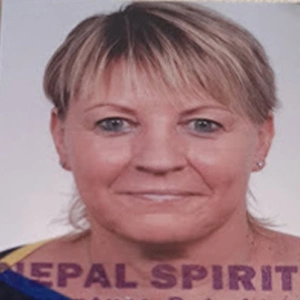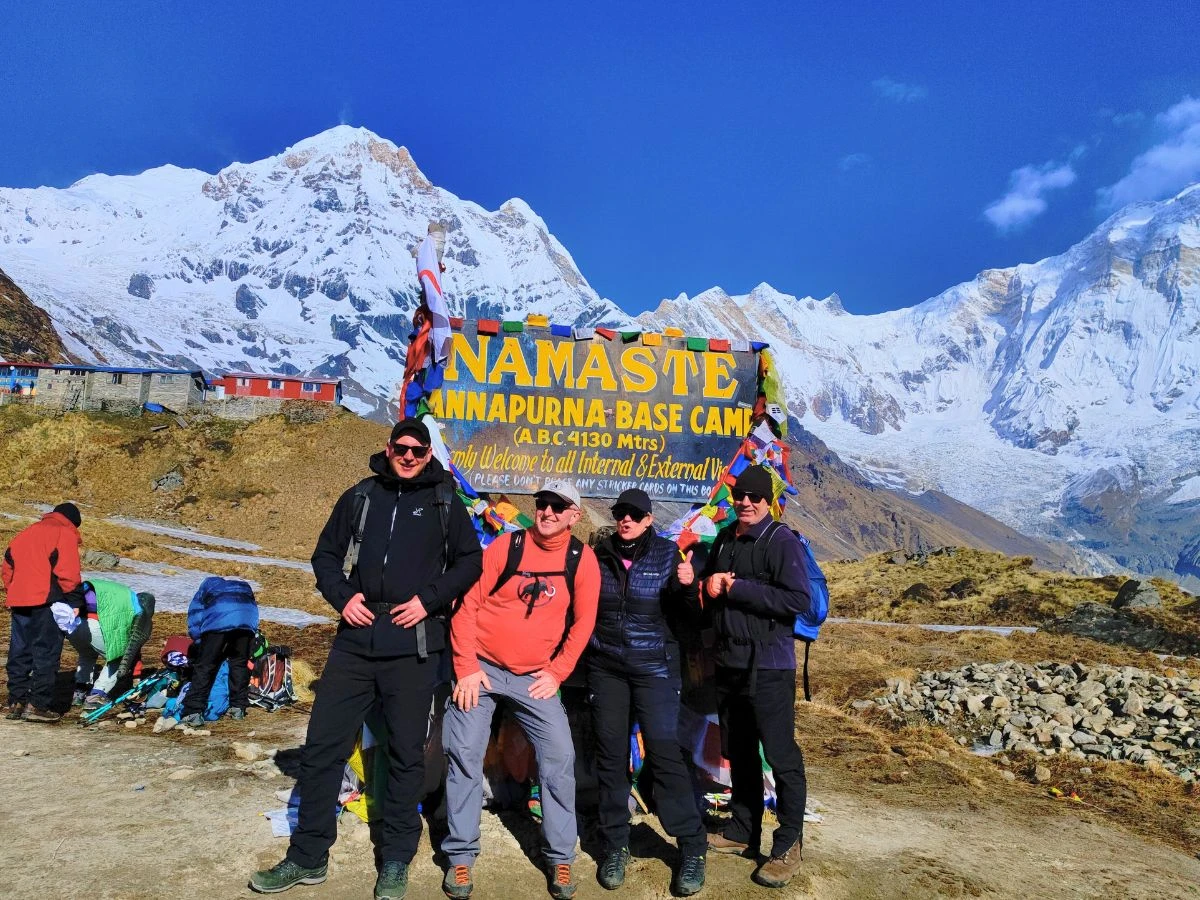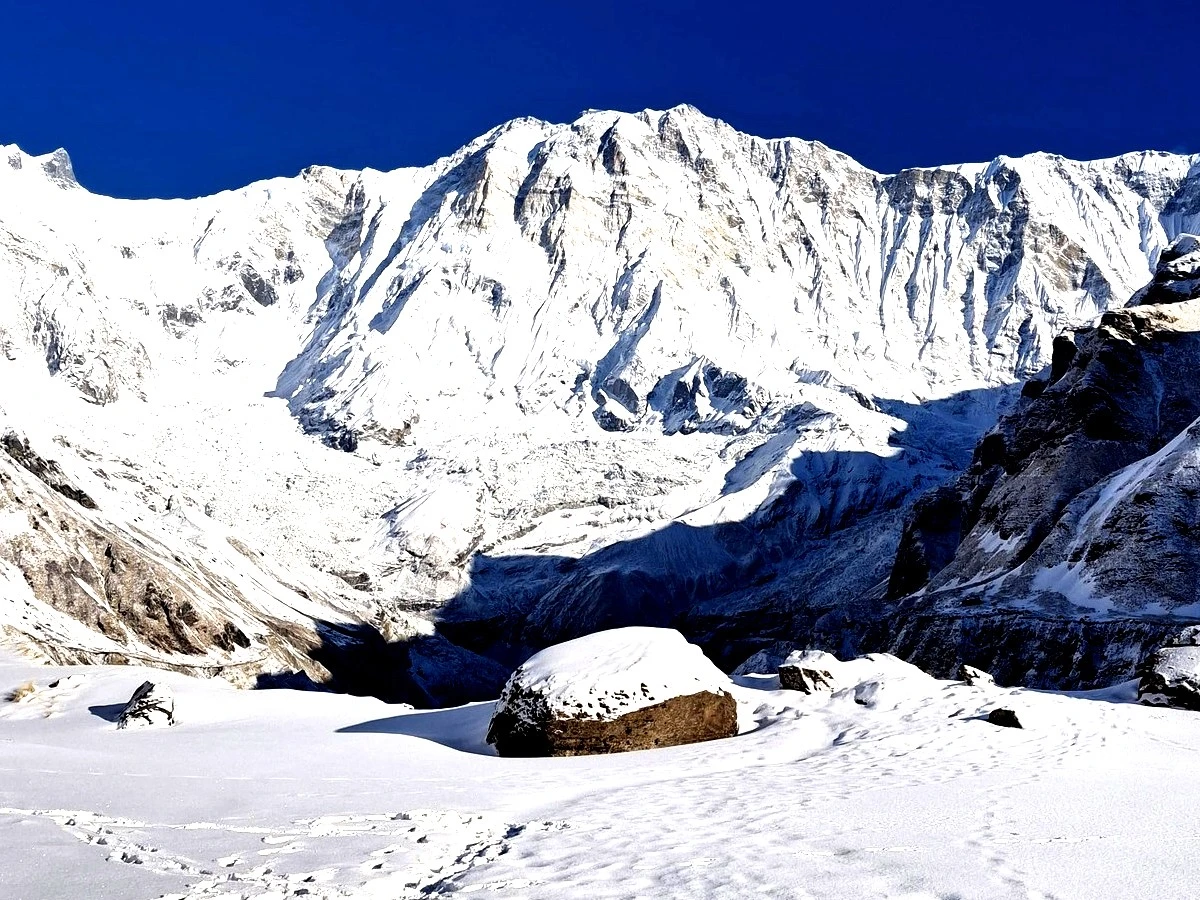Experience over two decades of trekking expertise in the Nepal Himalayas with local Sherpa guides and porters. Enjoy a scenic mountain flight from Kathmandu to Pokhara, and explore this beautiful lakeside city. Trek through charming farm villages and rhododendron-covered hills, and take in breathtaking mountain views from Poon Hill. Continue your journey to the magnificent Annapurna Base Camp, surrounded by towering snow-capped peaks. Unwind in the natural hot springs of Jhinu Danda and immerse yourself in the rich culture of the vibrant Gurung village of Chomrong.
Annapurna Base Camp Trek-14 Days
About Annapurna Base Camp (ABC) Trek: A Journey to The Himalayas
The Annapurna Base Camp is located at an altitude of 4,130 meters. It serves as a base camp for several peaks, including Mount Annapurna I, Annapurna South, Nilgiri Himal, Hiun Chuli, Singu Chuli, Tharpu Chuli (also known as Tent Peak), Gangapurna, Annapurna II, and Machhapuchhre, which is commonly referred to as Fish-Tail Mountain. The trek to Annapurna Base Camp is a remarkable journey that takes you through a variety of landscapes, including walking through tropical ethnic villages. It typically takes between seven and eleven days to complete the ABC Trek, depending on your starting and ending points.
14-Day Annapurna Base Camp Trek Highlights
The 14-Day Annapurna Base Camp Trek attracts both domestic and international trekkers throughout the year. Visitors enjoy the hospitality of local villages and the stunning mountain views along the trek. Here are some of the major highlights that make this trek particularly appealing:
1. Diverse Landscapes: The trek begins in subtropical forests and transitions to alpine meadows. As you ascend, the landscapes change, showcasing the region's natural beauty.
2. Spectacular Mountain Views: The Annapurna Base Camp Trek offers one of the best close-up views of the Annapurna massif, including peaks like Annapurna I, Annapurna South, Nilgiri Himal, Mt. Dhaulagiri, and the iconic Fish-tail Machhapuchre, among many others. Key viewpoints include ABC, Ghorepani, Magar Village, Poon Hill, Gurung Hill, Tadapani, Chhumrung, Deurali, and both MBC and ABC (Annapurna Base Camp).
3. Old-Style Villages: Starting from Pokhara, Nayapul, and Birethanti, the trail leads you through picturesque Magar and Gurung villages. Here, you can experience local culture and hospitality. The villages have established teahouses that serve as clean accommodation for trekkers, except Base Camp.
4. Sunrise at Poon Hill: Poon Hill (3,210 m) is renowned for its breathtaking sunrise views. It offers panoramic vistas of the Annapurna range and Dhaulagiri, which are simply mesmerizing at dawn.
These highlights make the Annapurna Base Camp Trek a unique and unforgettable experience for all who undertake it.
Accommodation on Trek
One important aspect of your Annapurna Base Camp journey is the overnight accommodation. Local villages along the route provide lodging primarily in tea houses or local lodges. Each lodge offers basic amenities, including beds, blankets, and hot meals. However, as you ascend to higher altitudes, the facilities become more basic. It is essential to carry a sleeping bag, especially if you are trekking during the colder months.
What You Need to Pack
As you prepare for the Annapurna Base Camp trek, be sure to pack the following essential items: -
1. Trekking Gear: Comfortable trekking boots, a waterproof jacket, warm clothing (even in spring or autumn, temperatures can drop at the base camp), a hat, gloves, and a good backpack are crucial for a successful trip.
2. Water Purification: Carry purification tablets or a water filter to ensure you have safe drinking water throughout the trek.
3. Snacks: Don’t forget to pack energy bars, nuts, and chocolate for an extra boost of fuel, which will help keep your energy levels high during your trek in the Nepal Himalayas.
4. Camera: As a trekker in Annapurna Base Camp, you won’t want to miss capturing the stunning mountain views. A camera is essential for this adventure, though a smartphone can also serve this purpose effectively.
Is Trekking to Annapurna Base Camp Safe?
The Annapurna Base Camp Trek is generally safe compared to more remote treks in Nepal. The trek route is easily accessible from the beautiful city of Pokhara. Road connectivity is available near the Jhinu Danda hot springs, making it easier to reach the starting point.
To ensure your safety, it's essential to acclimatize properly by taking your time and preventing altitude sickness. A good rule of thumb is to climb high and sleep low. For a safer trekking experience, consider traveling with a guide and a porter. While it is possible to trek independently, having a local Sherpa guide can greatly enhance your experience. They provide valuable local knowledge, help you stay on track, and assist with any problems that may arise along the way. Additionally, trekking porters can carry your bags, allowing you to focus fully on enjoying the trek.
Keep in mind that weather conditions can sometimes disrupt the trek, so it's advisable to check the weather forecast before starting your journey, especially during the monsoon season from June to August.
14-Day Annapurna Base Camp (ABC) Trek Overview
The 14-day Annapurna Base Camp (ABC) trek in Nepal is one of the most renowned trekking routes in the Annapurna Region. It offers breathtaking panoramic views and showcases rich cultural diversity. This trek is also known as the Ghorepani Poon Hill Circuit.
As you journey through the heart of the Himalayas, you'll navigate lush forests, terraced fields, and traditional villages inhabited by the Magar and Gurung communities. This trek provides not only a stunning natural experience but also a deep cultural immersion.
This trek is suitable for both beginners and experienced trekkers. The route to Annapurna Base Camp covers diverse terrains, ranging from subtropical forests to alpine meadows. Ultimately, you'll be rewarded with awe-inspiring views of the Annapurna Mountain range. This trek will leave you with a profound appreciation for the Himalayas and a sense of warmth from the hospitality of the local communities.
During the Annapurna Base Camp Trek, you’ll witness breathtaking views of the Annapurna Himalayan range, including: Dhaulagiri (8,167m), Annapurna I (8,091m), Annapurna South (7,219m), Gangapurna (7,455m), Annapurna III (7,756m), Machhapuchhre (6,997m), and more Himalayan panoramas.
As you pass through vibrant rhododendron forests, traditional stone villages, and terraced hillsides, the Annapurna Base Camp—nestled in a natural amphitheater of snow-capped peaks—marks a truly rewarding destination and an unforgettable achievement.
The Annapurna Base Camp Trek Cost and Packages
Our 14-day Annapurna Base Camp Trek Itinerary costs $1050 per person. It is reasonably priced and suitable for trekkers of all levels. The package includes a trekking permit, accommodations in the best teahouses along the route, and three hearty meals each day (breakfast, lunch, and dinner). Additionally, it covers both one-way and round-trip flights between Kathmandu and Pokhara, as well as an experienced local Sherpa trek guide and a reliable porter (one porter for every two trekkers).
Private vehicle transportation is also included before and after the trek. We can create a personalized Annapurna Base Camp itinerary tailored to your individual travel needs. As you embark on this incredible journey through the heart of the majestic Annapurna region, you will witness the breathtaking beauty of the Himalayas and immerse yourself in Nepal's rich cultural heritage.
During the trek, you will see the stunning peaks of Dhaulagiri (8,167 m), Annapurna I (8,091 m), Annapurna South (7,219 m), Gangapurna (7,455 m), Annapurna III (7,756 m), and Machhapuchhare (6,997 m), among others. You'll traverse lush rhododendron forests, terraced fields, and traditional Gurung and Magar villages. Reaching Annapurna Base Camp (4,130 m), nestled amid towering mountains, is a significant achievement. There, you will be rewarded with stunning views of the surrounding Himalayan giants.
Join us on this once-in-a-lifetime adventure as we embark on a 14-day personalized trek to Annapurna Base Camp, where the beauty of nature and cultural treasures welcome you at every turn.
Annapurna Base Camp Trekking Route
The Annapurna Base Camp Trek begins with a scenic mountain-view flight (approximately 25 minutes) flying between Kathmandu and the city of Pokhara. Nestled in a valley, Pokhara is adorned with the tranquil Begnas and Phewa Lakes, offering a mesmerizing reflection of the Annapurna Himalayas on its calm waters.
From Pokhara, our journey takes us through enchanting hills filled with rhododendrons and pine forests. During spring and summer, these hills transform into a magical garden as vibrant flowers bloom. We will pass through Tirkhedhunga, Hille, and Ulleri, making our way to Ghorepani. Here, we embark on the famous hike to Poon Hill (3,210m) for breathtaking mountain views and an unforgettable sunrise.
Poon Hill (3,210 m) is a highlight of the Annapurna Base Camp Trek, providing spectacular views of the Dhaulagiri, Nilgiri, Annapurna, and Manaslu mountain ranges at sunrise. Continuing our trek through serene forests, we eventually reach the glorious Annapurna Base Camp, surrounded by a magnificent amphitheater of snow-capped peaks.
After this unforgettable experience at Annapurna Base Camp, we will return to Pokhara. Along the way, we can relax in the rejuvenating hot springs of Jhinu Danda and pass through the vibrant Gurung village of Chomrong. The trek concludes with a short drive back to Pokhara and then onward to Kathmandu, all facilitated by the excellent service of Nepal Spirit Adventure.
The itinerary for the Annapurna Base Camp Trek is flexible and can be customized to meet your travel needs. The cost of the trek may vary based on factors such as daily expenses, wages, transportation, and hotel accommodations in Kathmandu and Pokhara.
"Embark on the Annapurna Base Camp Trek and allow Nepal Spirit Adventure to create an unforgettable journey tailored to your preferences."
Trip Gallery
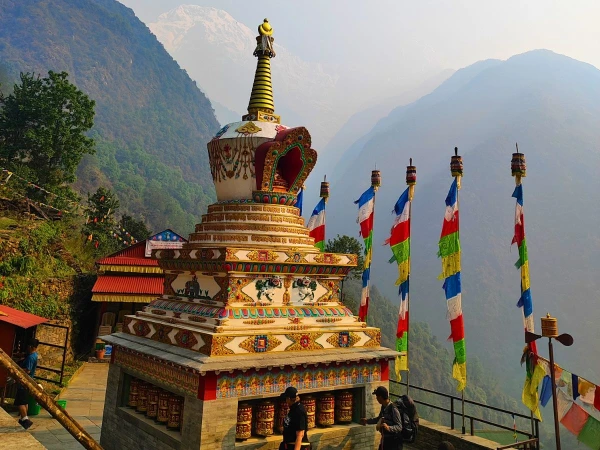
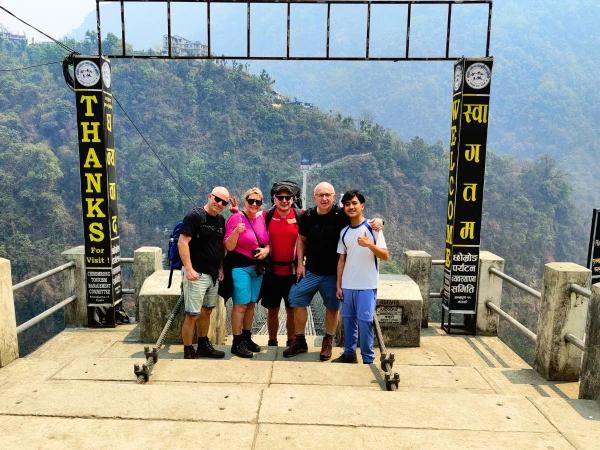
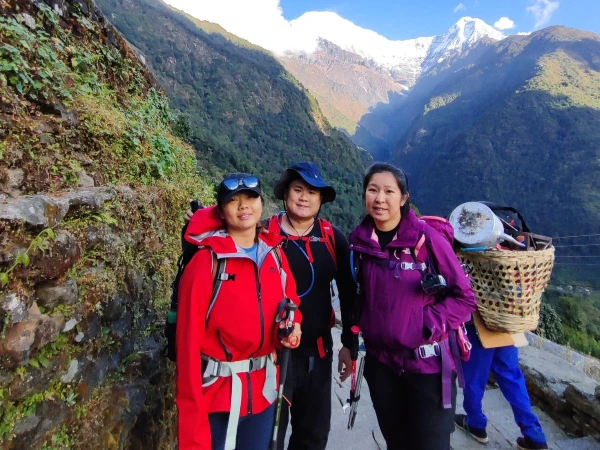
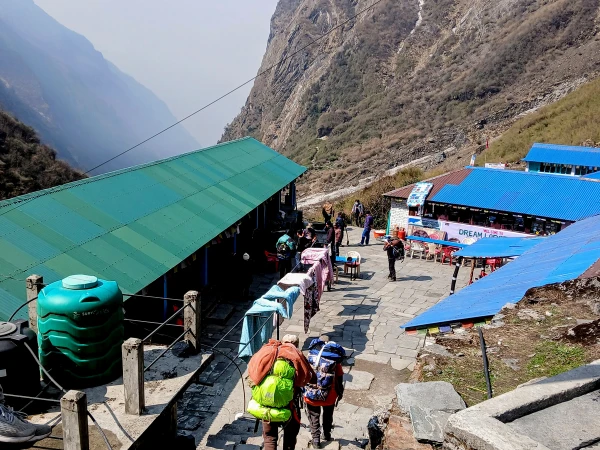

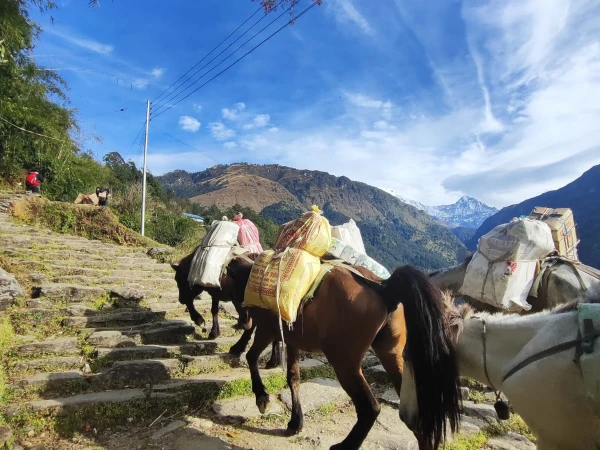
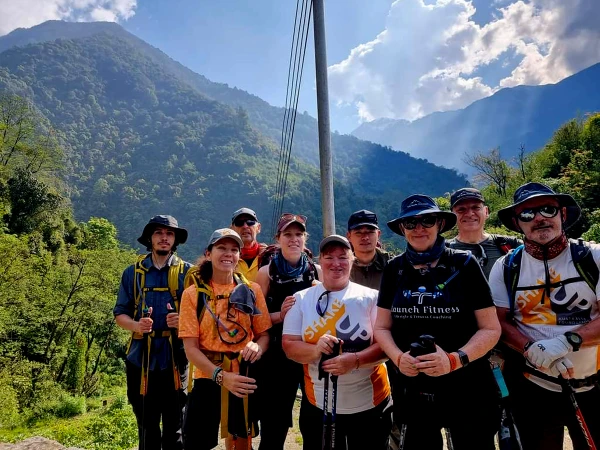

Short Itinerary
Arrival in Kathmandu, Airport Pickup, Transfer to Hotel
In Kathmandu, Trek Preparation
Fly to Pokhara, Drive to Birethanti, Trek to Ulleri 5 hrs
Approximately 6 hrs Trek to Ghorepani
Hike to Poon Hill (3,210m), Trek to Tadapani 6 hours
Trek from Tadapani to Chhomrong Approx. 6 hrs
Approx, 5 Hours Trek to Dovan from Chhomrong
Trek From Dovan to Deurali Approx. 5 hrs
Trek to Annapurna Base Camp 4 hrs Important Day
Trek back to Bamboo From ABC 7 hrs
Trek from Bamboo to Jhinu Dada 6 hrs Approx.
Jhinu Danda to Pokhara 1 hrs Trek & 3 hrs Drive
Fly to Kathmandu & Transfer to Hotel
Departure | Tour Ends
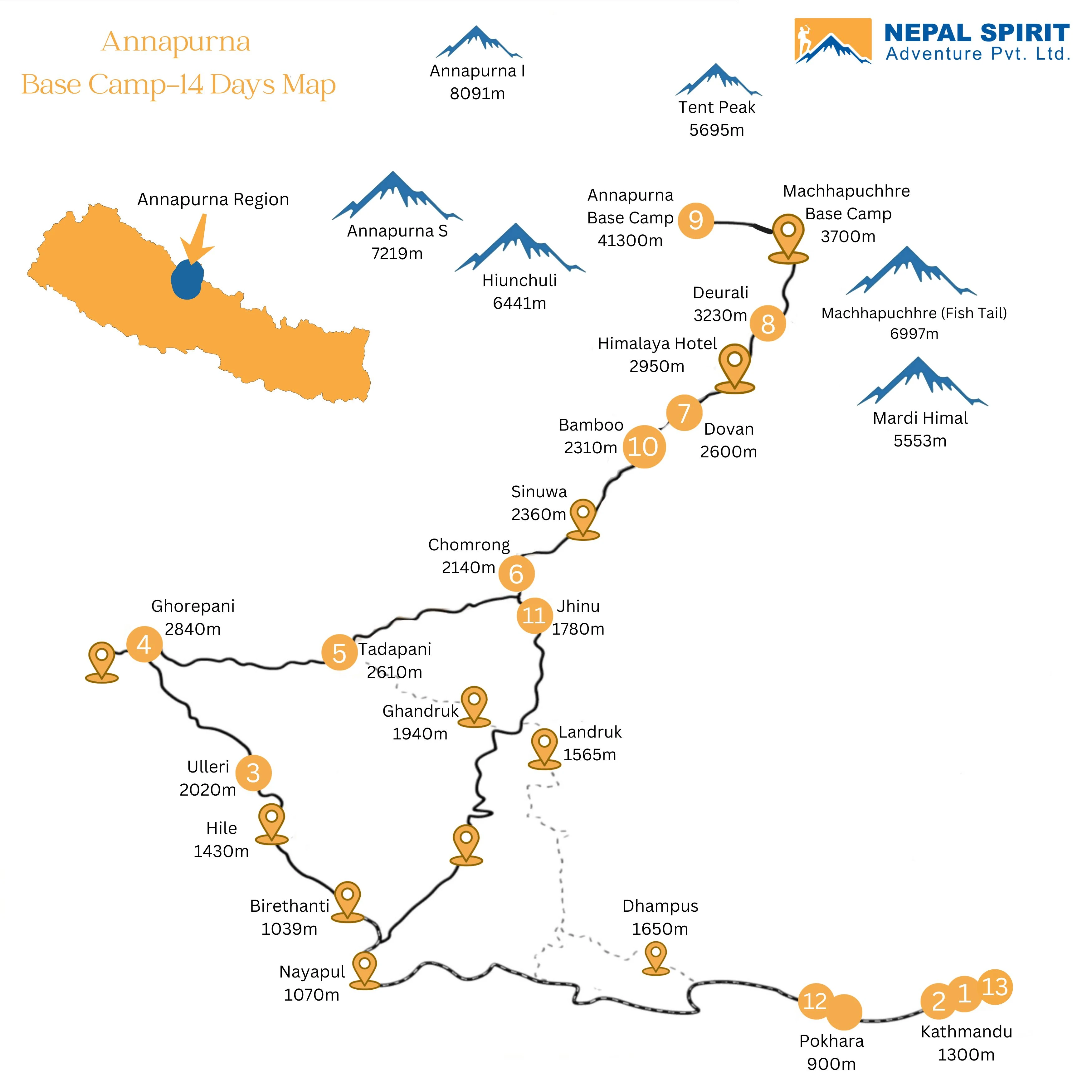
Annapurna Base Camp Trek-14 Days Itinerary
Arrival in Kathmandu, Airport Pickup, Transfer to Hotel
Upon arriving at Tribhuvan International Airport (TIA), you will complete the immigration formalities before proceeding to exit the airport. A representative from Nepal Spirit Adventure will be waiting for you in the arrivals terminal, holding a placard with your name on it. They will greet you and escort you to your hotel, which is about a 20-25 minute drive from the airport, depending on traffic.
No activities are scheduled for today, especially if you have a late flight. After checking in at the hotel, you’ll have some free time to relax, aside from our trip briefing meeting. We will inform you of the time for the trip briefing regarding the Annapurna Base Camp Trek itinerary for the following day and overnight in Kathmandu.
In Kathmandu, Trek Preparation
Today is a rest day, and breakfast is included in your trip package. After enjoying breakfast, you will attend a short trek briefing where your guide will explain what to expect on the trail. This will also be an opportunity for you to ask any questions you may have.
Following the briefing, you can review your packing list. Nepal Spirit Adventure provides necessary gear, including a sleeping bag, a down jacket, a duffel bag, a map of Annapurna Base Camp, a T-shirt, and a cap. Please note that the sleeping bag, down jacket, and duffel bag must be returned after the trek.
Fly to Pokhara, Drive to Birethanti, Trek to Ulleri 5 hrs
Today will be a very special day for you because you’re flying approximately a 25-minute scenic mountain flight with awesome views of the mountains, and the right-hand seat is reserved for better Annapurna Himalaya ranges.
Arrive in Pokhara beautiful city, and you’ll have a vehicle and drive towards Birethanti (1040 meters), an important trailhead for most treks in the Annapurna Region. It takes approximately one and a half to two hours from Pokhara to reach Birethanti (trek starting point). The first day of the trek, you’ll enjoy pastoral views, riverside fields, villages, farms, and small towns buzzing with activity on the way.
Your Annapurna Base Camp Trek in Nepal begins as soon as you cross the bridge over the Modi River and reach Birethanti. Hike up a staircase passing through villages like Ramghai and Sudame (1,160 meters), explore the villages as you make your way to Hile, a traditional Magar and Gurung ethnic village, and Tikhedunga, which means sharp (Tikhe) stone (Dunga). You will complete your trek by ascending over 3,000 stone steps and achieving an elevation gain of nine hundred (9,00 m) meters to reach Ulleri, a traditional Magar village requires 5-6 hours walking overnight in a lodge of Ulleri.
Approximately 6 hrs Trek to Ghorepani
Today marks your fourth day of trekking. You can enjoy breakfast while surrounded by the lush jungle, with stunning views of Mt. Fishtail (Nepali: Machhapuchhare) and Himchuli. After breakfast, you will complete your final packing for the day's trek. Your journey begins as you leave Magar village in Ulleri and continue climbing up to Banthanti. Along the route, you'll walk on a level jeep track before descending into a river gorge and heading upriver.
Before reaching Ghorepani, you will enter a vibrant tropical jungle alive with gray-faced langurs and the sounds of chirping birds. As you walk through the dense forests of Banthanti, located at an elevation of 2,210 meters, you'll be surrounded by rhododendrons, which are Nepal's national flower. After climbing for about two hours, you will arrive at Nangethanti, sitting at 2,460 meters, where you can take a break for lunch.
From Nangethanti, it takes approximately 2-3 hours to hike to your destination, Ghorepani. Ghorepani is a picturesque Magar settlement situated just below Poon Hill at an elevation of 2,840 meters. Before the construction of modern highways, this trail was commonly used by locals from Manang and Mustang, as well as traders traveling along the Tibet trade route.
Upon entering Ghorepani, your trekking permits and necessary documents will be checked at the ACAP office, and you will spend the night in Ghorepani.
Hike to Poon Hill (3,210m), Trek to Tadapani 6 hours
Today marks one of the most important days of the trek. Wake up early around 4:00 AM and get dressed. With your head torch lighting the way, begin your hour-long hike to Poon Hill, which sits at an elevation of 3,210 meters and offers an incredible viewpoint of the Himalayas. Once you reach the top of Poon Hill, you will be rewarded with a panoramic view of the Annapurna Mountain range and a stunning sunrise over more than twenty snow-capped peaks, including Mt. Dhaulagiri (8,167 m) and Annapurna I (8,091 m), both of which are among the ten highest mountains in the world.
After spending some time at Poon Hill to take photographs and savor the view, you'll descend to Ghorepani for breakfast. Following breakfast, you will start your trek with a gradual ascent to Deurali Pass (2,960 meters), another picturesque viewpoint of the Annapurna Himalaya range. Continue walking along a scenic ridgeline, then descend into a beautiful rhododendron forest. The trail will take you down to the rocky cliffs and charming streams of Banthanti (3,180 meters), which is a great place to stop for lunch.
After lunch at Banthanti, you'll embark on an approximately one-and-a-half to two-hour trek to Tadapani, a settlement of the Gurung people. This area is surrounded by the magnificent flora and fauna of the Annapurna Conservation Area. From Tadapani, you can enjoy closer views of the mountains, including Himchuli, Annapurna South, and the iconic Machhapuchhare (Fish Tail).
Trek from Tadapani to Chhomrong Approx. 6 hrs
Today, you can enjoy your morning breakfast with a stunning view of the mountains from Tadapani. After breakfast, begin your day with a scenic descent to Chuile/Kimrong Khola, passing through lush paddy fields. Cross the river via a metal suspension bridge and then ascend uphill past small shrines and paddy fields.
As you walk up the stone staircase, you'll encounter small villages inhabited by the Gurung local communities, along with tiny teahouses and farms. The trail will lead you to a beautiful rhododendron forest, where you can admire the snow-capped peaks of Mt. Machhapuchhre and Annapurna South. Continue your hike until you reach the Gurung village of Chhomrong, a well-known overnight stop for trekkers on the Annapurna Sanctuary Trek in Nepal.
Approx, 5 Hours Trek to Dovan from Chhomrong
Today marks day seven since your arrival in Nepal. You will trek from Chhomrong, at an altitude of 2,170 meters, to Dovan, which is 2,600 meters high—an elevation gain of 430 meters, taking approximately 5 to 6 hours of walking. After enjoying a delicious breakfast, you will depart from Chhomrong and begin your hike. The journey starts with a steep descent down 2,500 stone steps to the Chhomrong Khola, which you will cross via a metal suspension bridge. Following the bridge, you will ascend steeply to Lower Sinuwa, a climb that will take roughly 2 to 3 hours. During this stretch, you will travel approximately 2.5 to 3 kilometers while gaining 390 meters in elevation along a stone staircase.
Sinuwa is one of the larger villages in the region, and the walk from Lower Sinuwa to Upper Sinuwa may take some time. However, once you reach Upper Sinuwa, you will be rewarded with stunning views of the snow-capped mountain range. Maintain a steady pace and take breaks to hydrate and rest as needed. After passing through Kuldighar, you will descend steeply to Bamboo, a serene spot nestled in a lush bamboo and oak forest. A small signboard will indicate that you are entering a sacred area, where the consumption of meat and the carrying of non-vegetarian items are prohibited.
After a brief rest at a guesthouse in Bamboo, you will continue trekking to Dovan. The trail to Dovan consists of a mix of ascents, descents, and river crossings. Upon reaching Dovan, you will head to one of the few operational lodges to spend the night. From Sinuwa onwards, proper settlements or villages become scarce, with only a couple of teahouses available at each rest stop (Bamboo, Dovan, Himalaya, Deurali, MBC, and ABC) to cater to trekkers along the ABC route.
Trek From Dovan to Deurali Approx. 5 hrs
The elevation gain is approximately 600 meters!!
Today's trail is flatter and less steep than yesterday's. As you leave Dovan, you'll walk through a lush forest and arrive at a shrine dedicated to a Hindu goddess. This shrine is built next to a magnificent rock face, from which silvery waterfalls cascade down. Take a moment to pay your respects to the deity and capture some photos.
After some time, you'll reach a place called the Himalaya, named after the original teahouse that once stood there. There are now a couple of additional teahouses at Himalaya, where you can stop for a brief rest and refreshments.
As you continue your hike, you'll pass by an overhanging rock known as Hinku Cave, which was once a campsite for cattle herders and early Annapurna expedition groups. From Hinku Cave, it takes about an hour to reach Deurali, where you'll spend the night. Along the way, you'll cross a river located in an avalanche-prone zone, so please be cautious as you pass through this area.
Deurali sits at an elevation of 3,230 meters above sea level, surrounded by towering cliffs. Once you arrive, you'll stay in a cozy teahouse.
Trek to Annapurna Base Camp 4 hrs Important Day
Start your trek after breakfast as you cross a beautiful, narrow valley surrounded by tall mountains on either side. After approximately 2-3 hours of walking, you will arrive at Machhapuchhre Base Camp (3,700 m), located at the base of Fishtail Peak, or Machhapuchhre—a sacred peak where climbing is prohibited. Take a short break here to enjoy the stunning 360-degree view of the surrounding mountains.
While you are ready, leave Machhapuchhre Base Camp and begin your hike to Annapurna Sanctuary, your final destination. The trail ascends via a steep stone staircase that is shaded by the Annapurna Massif.
For most of the year, the trekking trail is covered in snow. After about 2 hours of hiking, you'll reach the 'Namaste Annapurna Base Camp' signboard. Take pictures to commemorate your achievement with your team. Head to a nearby teahouse and enjoy a well-deserved rest. Annapurna Base Camp, situated at an altitude of 4,130 m, is the highest point of this trek. Here, you’ll be surrounded by the towering, jagged peaks of the Annapurna Massif, as well as Gangapurna and Hiunchuli.
If the weather permits, consider making your way to the viewpoint of Annapurna Sanctuary to witness a beautiful sunset. Today, your trek will gain 900 meters than yesterday.
Trek back to Bamboo From ABC 7 hrs
Wake up early in the morning and head to the ABC viewpoint to witness a breathtaking sunrise over the snow-covered mountains. The soft glow of the morning sun illuminating the white peaks of Annapurna South, Annapurna I, Gangapurna, Hiunchuli, Baraha Shikhar, Tent Peak, and others is a mesmerizing sight. After enjoying the view, return to the teahouse for breakfast before embarking on your journey back to Bamboo, is requires approximately seven hours of walking back from Annapurna base camp.
On the tenth day of the Annapurna Base Camp Trek, you will say farewell to the stunning peaks of Mt. Annapurna and begin your descent along the same route to Bamboo. This downhill hike takes approximately 6 to 7 hours. As you navigate the steep descent to a lower elevation, be cautious of the slippery trails and areas that may be prone to avalanches. Remember to enjoy the breathtaking views of the snow-capped mountains as you make your way down.
You will walk alongside the Modi Khola River before reaching Bamboo.
Trek from Bamboo to Jhinu Dada 6 hrs Approx.
From Bamboo, follow a trail that features both flat paths and steep ascents and descents. After crossing the Chhomrong Khola, you will encounter a steep climb to reach the village. Take a brief rest here before continuing towards Jhinu Danda. The trail to the Jhinu hot spring winds down through wooded slopes towards Chhomrong, passing by Khuldi Ghar.
From Chhomrong, you will walk through fields and alongside small streams. In the distance, you can see the villages of Landruk and Ghandruk. As you take in the rural scenery, you will descend a steep stone staircase to reach the village of Jhinu Danda, which is situated on a ridge above the Modi River (Modi Khola).
Once you arrive, leave your luggage at a teahouse and head down to the riverside. Spend some time relaxing and soaking in a natural hot spring pool. There’s nothing better than a soothing dip in a hot spring after an exhausting trek.
Jhinu Danda to Pokhara 1 hrs Trek & 3 hrs Drive
On the final day of our ABC trip, you will leave Jhinu Danda and make your way down to the Modi River. You will cross the river via the longest suspension bridge in the Kaski District, then reach the jeep station. From there, you will board a jeep and drive towards Pokhara.
Upon arriving in this lakeside city, you can check into your hotel and spend the rest of the afternoon at your leisure. You have the option to either relax at your hotel or explore Pokhara on your own. There are many beautiful sites worth visiting, such as Gupteshwar Cave, Phewa Lake, Davis Falls, Peace Stupa, and the International Mountain Museum. If you would like to take a guided tour, we can arrange that for you.
Fly to Kathmandu & Transfer to Hotel
Breakfast is included, and you can enjoy morning sightseeing in Pokhara. In the afternoon, you'll fly back to Kathmandu, which takes approximately 25 minutes. The Nepal Spirit Adventure airport crew will pick you up from the domestic terminal and transfer you to your hotel. In the evening, a farewell dinner is also included.
Trip Option: If you plan to stay longer in Nepal, you might be interested in visiting Chitwan National Park or the birthplace of Buddha in Lumbini. These services are also available, and you can freely discuss with the management of Nepal Spirit Adventure.
Departure | Tour Ends
It's time to head home. Say goodbye to your guide and the friends you made during this adventure as you make your way to the international airport. Our driver will pick you up from your hotel and take you to Tribhuvan International Airport at least three hours before your flight departs.
If you wish to extend your stay, we would be more than happy to help you organize more unforgettable adventures in the Himalayas.
Cost Details
Includes
Hotel in Kathmandu & Pokhara:
- Three nights' hotel (twin shared room) in Kathmandu, including breakfast
- One night hotel (twin shared room) in Pokhara, including breakfast
Transportation:
- International and Domestic arrival and departure by private vehicle
- Pokhara to the trek beginning place ( Birethanti) by private vehicle
- Trek end place (Ghandruk pedi) to Pokhara by local jeep
- Kathmandu to Pokhara to Kathmandu by air
Trekking Food and Accommodation:
- Daily 3 meals a day (Breakfast, Lunch, and Dinner), choice from the menu
- Daily 2 cups of tea/coffee (black) during breakfast and dinner hours
- Guesthouse/teahouse/lodge accommodation on trek (twin shared room)
- Please do not mind sleeping in the ABC different types of rooms
Trek Guide & Porter:
- Experience trek guide
- Friendly, strong porter (1:2 trekkers)
- Guide, and porter, daily wages, food, accommodation, transportation, salary, and insurance
Permit and Equipment:
- Annapurna Base Camp route trek permit
- Down sleeping bag
- Down jacket
- T-short
- Duffel bag
Note: Trekking equipment is to be returned after the trip
First Aid and Customer Services:
- General first aid medicine for guests and staff
- Government and company service charge
- Every day phone call meeting with the trek guide, while on ABC
- Coordinated rescue service if it is necessary for the guest and staff
Excludes
Meals in the city and Nepal visa:
- Lunch and dinner in Kathmandu and Pokhara
- Nepal visa fee (you can get after your arrival)
- Extra nights' hotel in Kathmandu & Pokhara (due to an early return from a trek, or an extended stay in Nepal)
Personal Trek Equipment & Extra Expenses:
- Personal trek equipment (do not have, you can buy in Kathmandu)
- Personal trekking expenses: All the alcoholic or non-alcoholic drinks such as Coca-Cola, Fanta, Sprite, extra tea, coffee, beer,
- Energy drinks, whisky, chocolate biscuits, battery recharge, extra porters, hot shower, heater, phone calls, etc.
- Travel and trekking insurance and rescue operations are top requirements while you are on a mountain trek
- Tips for guides and porters
- International flights
Dates & Availability
Private TripThe online published trek departure date is guaranteed to run the trips. If it doesn’t match your holiday plan, contact us for another departure date. The ABC private trek can be organized at any time of the year.
Essential Information
What Is the Best Season for the Annapurna Base Camp Trek?
The Annapurna Base Camp Trek is best undertaken during specific months that offer favorable weather conditions and breathtaking mountain views. While the trek can be organized throughout the year, the following months are particularly recommended.
Mid-February to June:
During this period, the weather is generally clear and stable, allowing for excellent visibility of the magnificent mountain vistas along the Annapurna Base Camp Trek. The blooming rhododendron forests add a vibrant touch to the journey, enhancing the overall experience.
Last week of August to December:
This time frame also offers favorable weather conditions for the Annapurna Base Camp Trek. The skies are usually clear, providing unobstructed views of the surrounding peaks. The autumn colors of the landscape further enhance the scenic beauty of the trekking route.
At Nepal Spirit Adventure, we organize Annapurna Base Camp Treks throughout the year, ensuring that you have the flexibility to choose a time that suits you best.
What Kind of Transportation Do We Expect?
Transportation plays a crucial role in ensuring a smooth start and finish to the Annapurna Base Camp trek. At Nepal Spirit Adventure, we provide various transportation options to cater to your convenience and comfort as per your acceptable budget.
Private Vehicle:
As part of our ABC packages, we arrange private transportation for your international and domestic airport pick-up upon arrival in Kathmandu and for your final departure. Additionally, private vehicles are provided for the journey from Pokhara City to Birethanti before commencing the Annapurna Base Camp trek, as well as from Ghandrung Phedi back to Pokhara after completing the trek. This ensures a personalized and hassle-free travel experience.
Scenic Flight to Pokhara to Kathmandu:
As per our ABC trek package, both ways (Kathmandu-Kathamndu) mountain scenic flights are inclusive for saving your 2 days' holidays in Nepal because Kathmandu to Pokhara is (210km) away and takes about a 7-8 hours bus ride if you have a long holiday for Nepal, you can take a bus journey between both city. The two-way flight itinerary helps you particularly benefit as you will be feeling tired after the rigorous trekking activities, and provides an opportunity to relax and enjoy the sights of Pokhara, which is why we highly recommend both ways to take scenic flights.
The flight duration is around 25 minutes each way and offers mesmerizing views of the majestic mountains. These transportation options ensure your convenience, safety, and enjoyment throughout the Annapurna Base Camp trek, allowing you to focus on the incredible journey ahead.
Bus Service:
To travel from Kathmandu to Pokhara, we also offer deluxe tourist bus services. This scenic journey takes approximately 6-7 hours, allowing you to admire the picturesque landscapes, rivers, traditional villages, and breathtaking mountain views along the way. It is a delightful way to immerse yourself in the beauty of the region before reaching Pokhara, but you need a couple of extra days before starting the Annapurna Base Camp trek.
Is Food Included in the 14-day Annapurna Base Camp Trek?
The 14-day Annapurna Base Camp Trek package is priced at USD 1050 per person and includes all meals during the trek. You will receive three meals a day, comprising 13 breakfasts, 10 lunches, and 9 dinners, ensuring you are well-nourished and energized throughout the journey. The food is prepared at ethnic lodges that maintain high hygiene standards.
The menus at the teahouses along the Annapurna Base Camp Trek route are quite similar, offering a variety of dishes. You can enjoy delicious options such as MOMO (dumplings), noodles, pasta, potatoes, soups, and the popular Nepalese dish, Dal Bhat. Dal Bhat consists of steamed rice served with lentil soup and fresh seasonal vegetables, providing a nutritious and fulfilling meal. Breakfast and dinner will be served at the same teahouse or lodge, while lunch will be enjoyed along the trail, allowing you to experience the beautiful surroundings.
Some teahouses also offer Western food options like pizza, pasta, and French fries. Additionally, there may be extra costs for drinks, as most teahouses have a selection of beverages such as soft drinks, snacks, and beer. For breakfast, you can choose from various cereals, bread, and egg dishes, ensuring a satisfying start to your day on the trek.
What Kind of Accommodations Do You Provide for the Annapurna Base Camp Trip
We always ensure that our guests enjoy the best accommodations available throughout the trekking period, as well as in the cities of Kathmandu and Pokhara, according to our recommended trip itinerary packages. Our Annapurna Base Camp Trek package includes twin-sharing accommodations both in the city and during the trek. In Kathmandu and Pokhara, we provide tourist-standard hotels to ensure a comfortable stay.
During the ABC trek, we arrange comfortable lodges, traditionally known as teahouses. Each teahouse features a central communal area with a large stove, creating a warm and inviting atmosphere for trekkers. The bedrooms in the lodges are not heated and typically contain two beds, along with mattresses, pillows, and blankets. However, we strongly recommend bringing your sleeping bag—a 3-season bag is usually sufficient.
The teahouses generally offer gas-powered showers, and the toilets are mostly sit-down flush toilets, although some lodges may have squat toilets.
What Is Possible for drinking Water on the ABC Trek Route?
During the ABC trek, having access to safe drinking water is crucial, especially on a high-altitude journey. We recommend drinking at least 3-4 liters of water each day to help prevent dehydration and altitude sickness (AMS). Whenever possible, purchase sealed, packaged mineral water, which is available at local shops and lodges.
Please remember that while river, spring, and tap water may appear clean, without water purification, you can not drink them directly. To make it safe for consumption, you must use water purification tablets or a suitable filter. You can buy boiled water from any lodge along the trek. The cost of boiled water and sealed, packed water typically ranges from $1 to $2 per liter, and it may be pricier at the base camp of Annapurna.
Additionally, it's important to carry extra Nepalese rupees for all drinks—both alcoholic and non-alcoholic—as well as for chocolate biscuits and hot showers. These items are available at every teahouse along your journey to the ABC trek.
What Experience is Required for the ABC Trek?
The Classic Annapurna Base Camp Trek is a moderately challenging trek designed for enthusiastic walkers who can hike for 5 to 7 hours a day while carrying a light backpack. Trekking at high altitudes is more physically demanding than walking at lower elevations. However, if you are in good health, maintain average physical fitness, and possess a positive attitude, self-confidence, and strong determination, you can complete this trek.
To prepare, it is beneficial to engage in regular exercise and jogging for several weeks before your trip to enhance your strength and stability. Previous hiking experience is helpful, but no technical skills are required for this journey.
If you have any pre-existing medical conditions, such as heart, lung, or blood diseases, it is crucial to consult your doctor before embarking on this trek. Additionally, please inform Nepal Spirit Adventure of any health conditions before booking to minimize the risks associated with altitude sickness.
Is the Annapurna Base Camp Trek Suitable for Me?
The Annapurna Base Camp Trek is a challenging adventure that requires several days of strenuous hiking in the foothills, culminating at the base camp itself. During the trek, you can expect to hike for approximately 6 to 7 hours each day, often at altitudes exceeding 4,000 meters. It's crucial to be aware of the risks associated with high-altitude sickness. We recommend visiting our altitude sickness guide for more information.
To ensure you are well-prepared for this trek, it is essential to be in excellent physical condition and overall good health. Engaging in training activities before your trip is highly recommended.
Re-charging Batteries (electronic items)
You can recharge your batteries and devices using either electricity or solar power sources. In Nepal, the power supply ranges from 220 to 240 volts, 50 MHZ at 50 cycles per second. You will need a plug adapter for socket compatibility, which you can purchase in Kathmandu before your trip, as the plugs in Nepal may differ from those in your home country. Please note that there may be a small fee per hour for using the recharging facilities.
What Our Guests Say?
I had dreamed of reaching to Mt. Everest base camp trek with my Mother, but due to the bad weather, we were not able to flight to Lukla from Kathmandu. Nepal Spirit Adventure’s Ram diverted our trip to Annapurna base...
Thank you Nepal Spirit Adventure! Organized the best trek for us, and we had a great time with your people, they were the best guides and assistance, we were supposed to visit ABC last year due to short time we...
The mountains were beautiful, friendly people lived there, and a rich culture & nature. The trek wasn’t easy at all, but we managed to make it. The lodge accommodations were basic after the Chomrung village. We understood it wasn’t easy...
